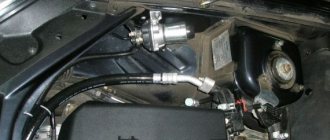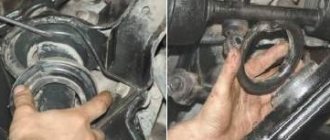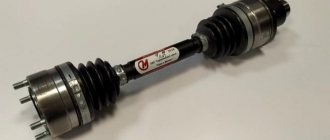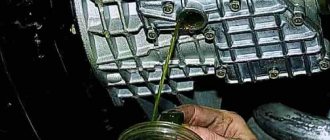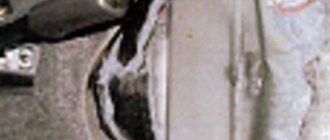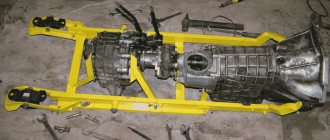07/18/2021 12,190 batteries
Author: Ivan Baranov
To improve the safety of their vehicle, drivers install a battery disconnect switch. It can be purchased at a specialized store, or you can make it yourself. The article provides general information about the device and instructions for its manufacture.
[Hide]
Power off button
A battery ground disconnect device (BMA) is a mechanism that short-circuits or opens the negative cable in a vehicle's electrical wiring. The switch is implemented using a button or toggle switch, which is installed in the passenger compartment so that the driver can safely turn off the power without opening the hood or disconnecting the negative terminal from the battery.
Before you buy a car weight switch button, you should decide on its purpose. If you need a switch just to disconnect the power, then you can buy and install a cheap button. And, if you need a switch as an additional means of protection against vehicle theft, then you need a button of a more complex design.
But, basically, the main switch is installed for safety, and not as an anti-theft device.
Purpose and role
The mains switch is a switching device. With its help, it is possible to organize the disconnection of the battery from the vehicle ground in order to prevent the battery from discharging in case of long-term parking of the vehicle.
An additional mains switch can act as an anti-theft device. The button will prevent intruders from starting the engine. The advantage of such a device is that it can be hidden if necessary.
Today, remote switches are the most popular, gradually replacing manual devices. The advantages of this modification include:
- the ability to control a button in the KAMAZ cab;
- no need to open the battery compartment or hood to disconnect or connect ground;
- possibility of hidden installation of the device.
A distinctive feature of remote models is their simple design and clear operating principle.
How to make a power switch with your own hands
For those who want to create a shutdown mechanism themselves, there is a simple circuit for manufacturing. This type of switch will have no mechanical contacts. It can be used as a means of protection against car theft.
Circuit diagram of the mass switch The device has two conductors: a diode, a trinistor.
The thyristor in this mechanism is an electronic relay, which is switched on when pulses appear on the control electrode.
S1 is mounted inside the car in a hidden place. If you close the contacts of S1, then the desired impulse will appear, which will go to the thyristor, as a result of which it is unlocked, which leads to a decrease in resistance and current flows through the electrical wiring.
What does the main switch mechanism consist of?
The SCR allows current to flow in only one direction, from the battery to the network, but not from the network to the battery.
To allow the battery to be charged from the generator, a diode is installed in parallel with the SCR. The parts of the device are mounted on a duralumin corner. The wires used are stranded.
How to install a mass switch in a car:
Manufacturing Guide
For self-production, there is a simple VMA circuit without mechanical contacts, which ensures its reliability. An additional advantage of this design is the ability to use the device as an anti-theft device. The design of the device includes two conductors: a diode and a thyristor.
Scheme of a simple VMA
In this device, the thyristor is used as an electronic relay, which operates as soon as pulses appear on the control electrode. S1 is installed in a secret place in the car interior, and when the contacts are closed, the necessary impulse occurs. When a pulse arrives at the thyristor, it is unlocked, the resistance decreases sharply and a high voltage current flows through the network.
Thanks to the SCR, current flows only in the direction from the battery to the network.
To be able to recharge the battery from the generator, a diode is connected in parallel with the thyristor. The parts are attached to a duralumin corner. On one shelf, holes are drilled and semiconductors are attached, and on the second, holes are drilled for fastening material with which the device will be attached to the car body. For wiring, stranded installation wire is used.
Battery cable to interior
Installing the device consists of a sequence of steps:
- The battery terminal is connected to the SCR cathode terminal. The assembled structure is placed in a metal case.
- The control wire must be pulled from the engine compartment to the passenger compartment.
- To avoid making unnecessary holes in the body, you can use a brake pipe holder. To do this, remove the bottom and get a hole through which we pull the wire.
- We install the toggle switch on the steering column. To do this, you need to unscrew the screws of the cover, drill a hole in the column of the appropriate diameter and insert the toggle switch into it.
- Next, connect the wire that goes to ground to one of the terminals, and connect the control wire to the other.
If the device is used as an anti-theft device, then it is advisable to use a more powerful diode. Since its cooling is affected by a hidden installation in the engine compartment. It is necessary to measure the internal resistance of the diode with an ohmmeter when it is in the open state. The voltage should not drop more than 0.5-0.6 V, otherwise the battery charging process will be disrupted.
New factory VMA
Video
In this video, the skillful hands of experienced drivers make a button for remotely switching off the car's weight with their own hands.
Tips and recommendations on how to choose a weight for a car.
This video shows the choice of location, how to install and connect the button from a Kamaz car to a Mercedes car.
And this is for those who want to do it completely with their own hands.
There are several ways to create a mass switch. Anyone who bought mass buttons or made them themselves, write in the comments.
Source
Made an electric mass switch on a thyristor
Similar articles
33 comments on “I made an electric mass switch on a thyristor”
How did you measure the voltage before and after the diode, if one electrode is on ground?
Alexander, + on Akuma, — on Akuma 14.3; — on the plate 14.1; battery itself is 13.6
Egor, you need to measure according to the masses, those bodies. As they said, maybe the capacity is worth it.
Mikhail, I’m writing the voltage with the engine running
Egor, well, everything is fine - the thyristor drops 0.7 V... although this is not enough... what kind of thyristor?
Mikhail, why is it 14.3 on Akuma??
Egor, you wrote that 13.6...
Egor, here is your answer. This is the generator voltage. That’s why there are more npr acb. Place interantic mass. Otherwise it’s good if you stall nearby.
Mikhail, 13.6 Akum himself with the engine turned off
Mikhail, he accelerated and it showed 14.3
Egor, throw it out and forget it, otherwise see what I wrote above
Mikhail, yes, I understand that this is nonsense and I wouldn’t do this to myself, but my neighbor is afraid that while he’s at work his car will burn down, he’s already jacked up the whole mass by removing it every other day
Egor, the remote mass costs 10 euros...
Egor, it’s cheaper from disassembly
Egor, as a last resort, install a larger relay (not to the starter) like RB or RS
Mikhail, I’ll tell him, but this scheme also works in theory, on Akuma 14.3 and this is normal
Egor, THERE CAN'T BE NORMAL VOLTAGE THERE.
Egor, it costs 4 euros - it’s as reliable as
Mikhail, you need to constantly pull the hood, in short, let him look for the factory remote
Egor, you can put it in the cabin...
Mikhail, why do you think 14.3 is not enough for a charge?
Egor, have you ever heard about the voltage drop on a diode?
Mikhail, yes, but there is FACT 14.3
Egor, apply for a Nobel Prize...you've found a superconductor
Mikhail, before that there was a shitty diode and yes, the charge would have been 13.6-13.8, I changed it to some kind of d30b that Google doesn’t know and it became 14.3
Egor, physics - no, I haven’t heard...
How does a thyristor close in a DC circuit? If there is enough current to hold the thyristor, the mass will not turn off. The scheme is one of the useless ones. A contact breaker must be installed in such places.
Mikhail, it opens, but the neighbor doesn’t listen and wants to leave it, winter will tell)
In general, the meaning is only fire safety. If the battery drops out, then you need to look for the reason and not block the switches
Mikhail, it’s done from a fire
Egor, in this case, only contacts, no thyristors. There are polarized relays specifically for these purposes, they are controlled by one button - press on, press again - off.
Source
Terminal care
To maintain battery terminals in working condition, it is necessary to take proper care of them in a timely manner. To do this, do the following:
- Remove the battery;
- Prepare a strong solution of baking soda. The terminals are lowered into it. You should keep them in the solution for about 5 minutes. During this time, bubbles can be seen rising from the metal. The terminals are removed when the bubbles stop flowing;
- The removed terminals are inspected; they should not be severely damaged by corrosion. Wipe the terminals;
- Apply special lubricant or technical petroleum jelly to the contact points.
Prevention should be carried out at least 2 times a year. Experienced motorists recommend doing this in spring and autumn. Article on the topic “How to lubricate battery terminals.”
Nissan Frontier Nismo 750Monster TURBO › Logbook › Disabling mass from the remote control
I decided to get a little confused again! (for the most impatient, the working circuit is in the last photo) After installing all sorts of things in my Monster, I had one problem: if I don’t pick up the car from the parking lot after more than 12 hours, any powerful battery runs out. I started looking for all sorts of ground switches, I thought I’d take some fancy one, but no... Well, I dug up a circuit on the net, sawed it a little, drilled it, soldered it, cut it off, screwed it on, insulated it, used Lego parts... And a couple of Soviet parts))) in Japanese -American monster...
"Mass" for old cars.
Many more cars , mostly Soviet-made, can be found throughout the CIS. These are “Volga”, “Muscovites”, “Zhiguli”, “UAZ”, “Cossacks”, “Luaz”.
And if someone installs switch , then these are mostly mechanical switches . We all know the postulate of mechanics, “the fewer mechanically moving parts, the more reliable the device” and mechanical switches are no exception.
Judge for yourself, such switches do not work in a completely favorable environment. Contacts wear out and oxidize, hence their unreliable operation.
In the absence of ground switches car remove the negative wire from the battery during breaks between using the vehicle.
Here, in a few words, I want to say that it is impossible to disconnect the wires from the battery in modern cars , as this can affect the operation and serviceability of on-board computers and other electronic devices.
An alternative replacement for the mechanical switch can be the more reliable and durable electronic ground switch system given below. The circuit is very simple, anyone can make it, not even a radio amateur.
It is important to have basic skills in using a soldering iron. The electronic device consists of only a few parts, thyristor , diode and a microswitch.
There are only three parts, not counting the terminal wire. Tools you will need are a 40-watt electric soldering iron, tin-lead solder and rosin.
Wiring diagram of the mains switch
The thyristor and diode are mounted on a duralumin plate measuring 100x50x3 mm. You can use a corner made of the same metal with a shelf width of 50x50 mm.
It is necessary to drill two holes in the plate with diameters of 21 mm and 6.2 mm; they are necessary to secure the thyristor and diode . The threaded part is inserted into the drilled holes, a thyristor , and a diode .
The markings before drilling holes must be calculated so that the semiconductor devices are not too close to each other.
The duralumin plate is also a common conductor, since it connects the anode of the thyristor and the cathode of the diode . (See circuit diagram).
The thyristor and diode are secured in the holes with nuts, having previously placed washers, but there is no need to tighten them too much yet.
Now it is necessary to connect the cathode thyristor and the anode diode soldering. When soldering, it is advisable to use a heat sink so that electronic devices do not fail due to overheating.
to the cathode of the thyristor , which will be connected through the terminal to the negative of the battery .
Solder one wire coming from the microswitch to the control electrode of the thyristor with "mass".
When all connections are made, it is necessary to tighten the thyristor and diode .
We have made all the connections, now let’s figure out how the electronic switch .
Initial state: the negative cable of the battery is disconnected from ground.
Due to the fact that current flows through the thyristor in one direction and in this case the battery will not be recharged from the car generator. To eliminate this drawback, diode D245 was introduced into the circuit, which is connected in reverse polarity with respect to the thyristor .
If we turn off the microswitch, the voltage will not flow to the control electrode, the thyristor will close, i.e. its resistance will increase and the “mass” will be turned off.
It is advisable to place the electronic device in a suitable box and secure it under the hood of the car in a convenient place.
Install the microswitch in a secret place inside the car . Pass the wire going from the microswitch to the control electrode of the thyristor through any technological hole in the engine compartment.
The described electronic mass switch also has another quality. It can be used as an anti-theft device.
Source
Causes and symptoms of poor engine grounding
Engine malfunction may be caused by:
- Loose, rusty, or damaged ground terminals or wires
- Weak, damaged or corroded battery ground terminal
- Poorly installed or repaired components
Symptoms of a poor motor ground may include:
- Dim lights
- Flickering lights
- Electrical devices operate erratically
- Faulty fuel pump
- A slipping or burnt A/C compressor clutch
- Intermittent sensor failure
- Throttle or transmission cables are damaged
- Hard start
- Low battery
Often bad grounds are relatively easy to diagnose and correct, usually in a matter of minutes. You can diagnose and repair in your own garage using just a digital multimeter (DMM) and some common tools.
If you don't know where all the engines or transmissions are located in your vehicle, you may want to consult your vehicle's repair manual. You can get a relatively inexpensive copy through Amazon. Haynes manuals come with step-by-step procedures for many maintenance, repair and troubleshooting projects. This way, you will recoup your small investment in a short time.
FINE. So grab your multimeter and let's find those bad grounds in your car.
Corrosion or damage to grounding straps can cause electrical accessories to malfunction.
De-energize the board: why do you need a mass switch and can it be installed on a modern car?
Disclaimer. The author is by no means a retrograde and is not trying to “attach a typewriter keyboard to a tablet.” However, the decisions of previous decades, it turns out, under certain conditions, have a right to life.
The electrical equipment of modern cars is full of various “smart” units, which are assigned dozens of comfort and safety functions. However, in some ways the electrics of today’s cars are not far removed from the cars of half a century ago - for example, the voltage in the on-board network is still 12 Volts, and in many cases the lead-acid battery remains the “guardian of life” (not so long ago we explained why they are not changed Whether lithium-ion), the “minus” is located on the body, and the problem of current leakage with a significant increase in the number of consumers has become even more urgent. And today we will find out what a ground switch is, whether it is needed at all in a modern car, and in what cases its use is permissible and even desirable.
